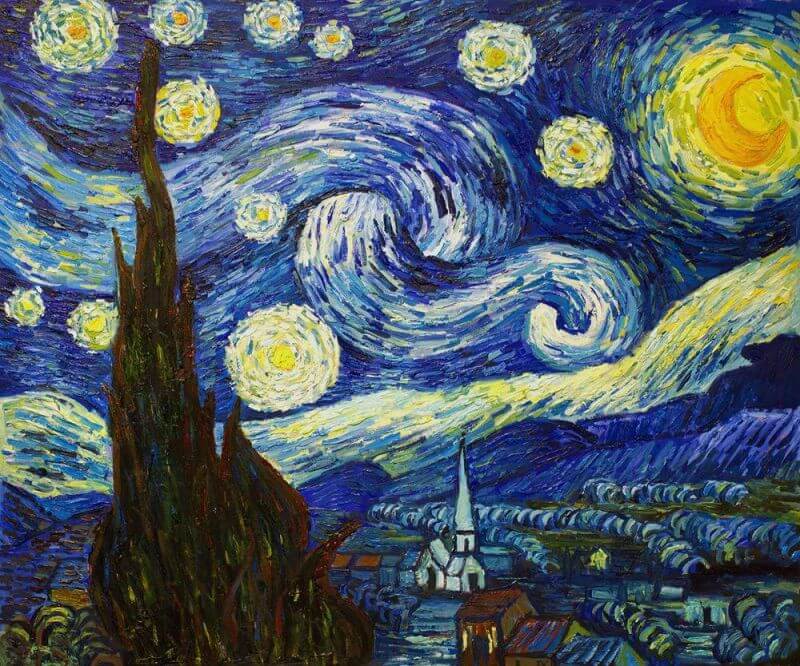We had a wonderful time at the Van Gogh Exhibit: The Immersive Experience. This is a new digital way to experience information about the artist. The VR experience was a novelty something I haven’t done before that is experienced in a separate gallery from the digital projections. The virtual reality experience will take visitors on a 10-minute journey on “a day in the life of the artist,” allowing them to see the inspiration behind some of van Gogh’s most famous works of art. Other studios and galleries, including a drawing studio, will give visitors an even more in-depth look at the artist. One thing I would suggest to learning about Van Gogh is his signature Impasto. This is a technique used in painting, where paint is laid on an area of the surface thickly, usually thick enough that the brush or painting-knife strokes are visible. Paint can also be mixed right on the canvas. When dry, impasto provides texture; the paint appears to be coming out of the canvas.
#vangoghimmersivexperience #vangoghimmersion #vangoghimmersive
#vangoghimmersiveexhibit #vangogh #vincentvangogh #art
There are a large number of visual effects that an artist using the technique may be striving to achieve, but the most important ones are the added bulk and the play of light and shade. The brush-strokes may be straight, rounded or cross-hatched. Some artists only used this approach for certain elements of their works, with the aim of emphasizing them and bringing them to the fore, while others covered the whole canvas with an uneven ripple effect.
The impasto technique is usually associated with the work of Vincent Van Gogh. It is said that he applied the paints directly onto the canvas and simply mixed them together with his own fingers. One of the examples of the impasto technique in his oeuvre is the painting The Starry Night. Here, in order to make the stars in the night sky appear as bright as possible, he strove to apply paint with an extremely thick consistency, using bold brush-strokes, thereby highlighting the lights.

In order for the brush-strokes to appear even thicker and more expressive, artists did not shy away from using thickening agents on occasion. This would lend the painting an incredible texture. One of the substances widely used for this purpose, for instance, was wax. With each brush-stroke, the touches of the palette knife or spatula were imprinted on the painting. Works featuring this technique were produced by artists from a wide range of movements and eras: the Renaissance, the Baroque period, Impressionism, Expressionism, Post-Impressionism. Interestingly, the Impressionists applied paste from tubes directly onto the canvas, creating the outlines required with a brush once the paint was in situ. In the era of Impressionism and Expressionism, this technique made it possible to obtain a wonderful mirror-image of a crumpled or broken surface, to pick out areas of light amid the darkness, and to emphasize a space. It was the perfect way to convey feelings, concerns and emotions for the paintings of the Expressionists, for them to express their egos on canvas, and to show what is accessible only to those who see, not to those who merely look.
There are a whole range of methods and rules for applying paints to bases:
- With the help of a brush, a palette knife, a tube or using additional additives;
- The thick layer should be allowed to dry in conditions whereby the process can take place as slowly as possible. This approach protects the layer of pigment from cracking up and prevents wrinkles from appearing;
- If the ingredients are too fatty, this will definitely make it more difficult to create textures and expressive brush-strokes;
- Flat brushes or small brushes made of artificial horsehair will be ideal for this technique;
- If you add sawdust, sand or very fine grit to the pigment, this will lend a unique aspect to the texture and allow you to really liven up your work, and above all – to increase the volume of each brush-stroke;
Some artists cover their completed paintings with a special glaze. Its thin film provides excellent protection that will prevent cracks and wrinkles appearing in the pigment and prevent it from peeling.
source: SUNY Purchase, Pearl Paint, Old Holland 1664, Van Gogh Albany, NY Exhibit: The Immersive Experience #vangoghimmersivexperience #vangoghimmersion #vangoghimmersive #vangoghimmersiveexhibit #vangogh #vincentvangogh #art #impasto
